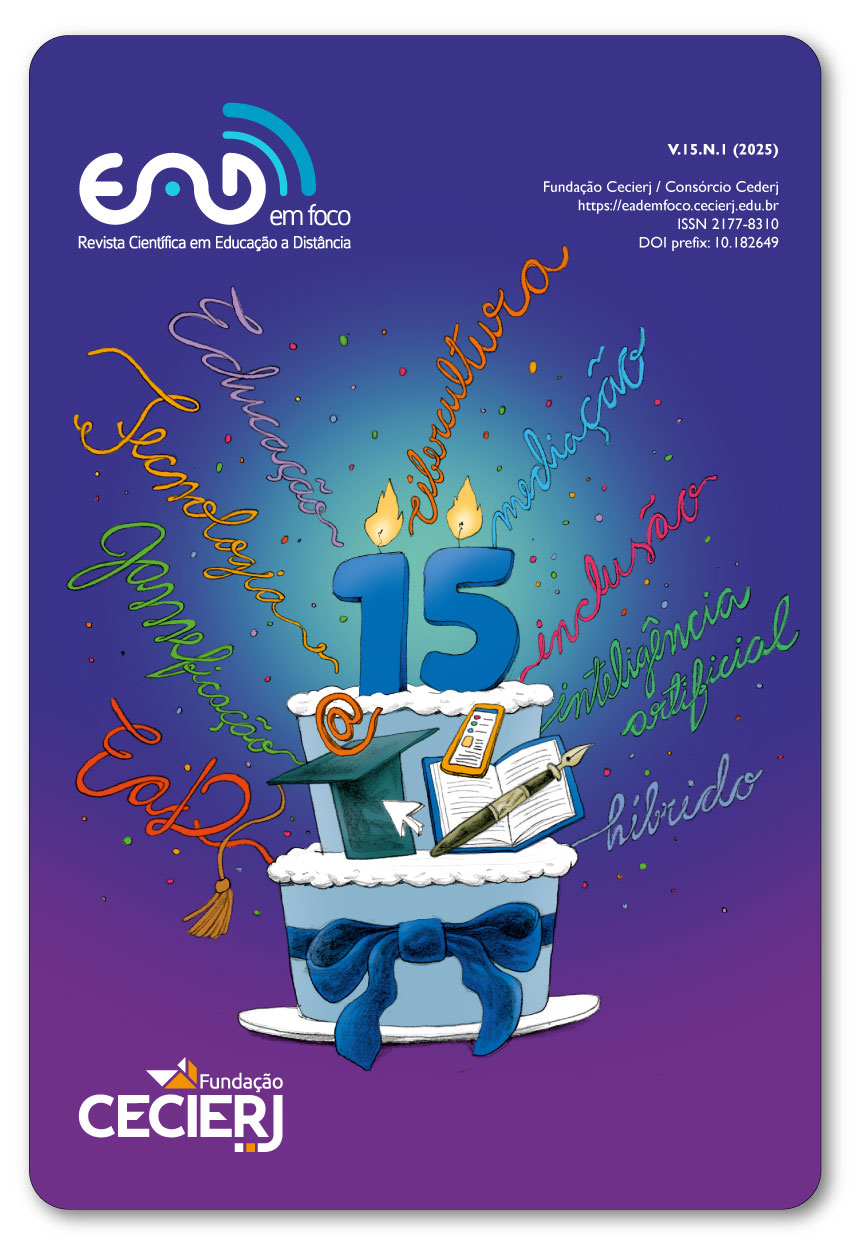Development of an Interface for Visualizing Engagement Profiles Created from Educational Data Grouping
DOI:
https://doi.org/10.18264/eadf.v15i1.2386Palabras clave:
Distance Education (EaD), Student engagementResumen
The distance learning modality faces challenges in improving teaching efficiency, reducing student isolation, and enhancing support technologies. Research focuses on student engagement, but large class sizes make individual tracking difficult. This study aimed to develop an interface for visualizing engagement profiles based on clustered educational data. The Design Science Research (DSR) methodology was used, which involved: 1) problem investigation through interviews with teachers; 2) development, selecting engagement variables, clustering algorithms, and visualization metaphors; 3) evaluations, with feedback from teachers and data visualization experts. Key findings include: 1) the need for tracking tools and the importance of forums, as mentioned by teachers; 2) the “what-why-how” structure for selecting the appropriate visualization; 3) features to ensure greater usability in dashboards, such as reducing scroll and grouping visualizations by information type, as pointed out by experts.
Keywords: Distance education. Engagement. Data visualization. Usability.
Descargas
Citas
ALANEME, G. C.; OLAYIWOLA, P. O.; REJU, C. O. Combining traditional learning and the e-learning methods in higher distance education: Assessing learners’ preference. In: 2010 4TH INTERNATIONAL CONFERENCE ON DISTANCE LEARNING AND EDUCATION, 2010, [s. l.], . [S. l.]: IEEE, 2010. Disponível em: http://dx.doi.org/10.1109/icdle.2010.5606008 Acesso at: 30 Jul. 2024.
BANERES, D. et al. A Predictive Analytics Infrastructure to Support a Trustworthy Early Warning System. Applied Sciences, [s. l.], v. 11, n. 13, p. 5781, 2021. Disponível em: Acesso at: 30 Jul. 2024.
DOWDING, D.; MERRILL, J. The Development of Heuristics for Evaluation of Dashboard Visualizations. Applied Clinical Informatics, [s. l.], v. 09, n. 03, p. 511–518, 2018. Disponívelem: Acesso at: 30 Jul. 2024.
FARAHMAND, A.; AKBER DEWAN, M. A.; LIN, F. Constructing Intelligent Learning Dashboard for Online Learners. In: 2021 IEEE INTL CONF ON DEPENDABLE2021, [s. l.], .Anais [...]. [S. l.]: IEEE, 2021. Disponível em: http://dx.doi.org/10.1109/dasc-picom-cbdcom-cyberscitech52372.2021.00141 Acesso at: 30 Jul. 2024.
HASSENZAHL, M.; TRACTINSKY, N. User experience - a research agenda. Behaviour & Information Technology, [s. l.], v. 25, n. 2, p. 91–97, 2006. Disponível em: Acesso at: 30 Jul. 2024.
JAYASHANKA, R.; HETTIARACHCHI, E.; HEWAGAMAGE, K. P. Technology Enhanced Learning Analytics Dashboard in Higher Education. Electronic Journal of e-Learning, [s. l.], v. 20, n. 2, p. pp151-170, 2022. Disponível em: Acesso at: 30 Jul. 2024.
KONO, M. et al. Design and Study of a Multi-Channel Electrical Muscle Stimulation Toolkit for Human Augmentation. In: PROCEEDINGS OF THE 9TH AUGMENTED HUMAN INTERNATIONAL CONFERENCE, 2018, New York, NY, USA. Anais [...]. New York, NY, USA: ACM, 2018. Disponível em: http://dx.doi.org/10.1145/3174910.3174913 Acesso at: 30 Jul. 2024.
LACERDA, D. P. et al. Design Science Research: método de pesquisa para a engenharia de produção. Gestão & Produção, [s. l.], v. 20, n. 4, p. 741–761, 2013.
LUIS CAVALCANTI RAMOS, J. et al. A Comparative eStudy between Clustering Methods in Educational Data Mining. IEEE LatinAmericaTransactions, [s. l.], v. 14, n. 8, p. 3755–3761, 2016. Disponível em: Acesso at: 30 Jul. 2024.
MACÊDO, P. H.; SANTOS, W. B.; MACIEL, A. M. A. Análise de Perfis de Engajamento de Estudantes de Ensino a Distância. RENOTE, [s. l.], v. 18, n. 2, p. 326–335, 2021. Disponível em: Acesso at: 30 Jul. 2024.
MUBARAK, A. A. et al. MOOC-ASV: analytical statistical visual model of learners’ interaction in videos of MOOC courses. Interactive Learning Environments, [s. l.], v. 31, n. 5, p. 3055–3070, 2021. Disponívelem: Acesso at: 30 Jul. 2024.
MUNZNER, T. Visualization Analysis and Design. [S. l.]: CRC Press, 2014. 2014.
OLIVEIRA, P. L. S. de et al. Identificação de Pesquisas e Análise de Algoritmos de Clusterização para a Descoberta de Perfis de Engajamento. Revista Brasileira de Informática na Educação, [s. l.], v. 30, p. 01–19, 2022. Disponívelem: Acesso at: 30 Jul. 2024.
SOUTO REINHEIMER, W.; DUARTE MEDINA, R. GAMIEFECTS: A proposta de um framework para apoiar a avaliação de gamificação em contextos educacionais. RENOTE, [s. l.], v. 19, n. 2, p. 122–131, 2021. Disponível em: Acesso at: 30 Jul. 2024.
SEDRAKYAN, G. et al. Guiding the choice of learning dashboard visualizations: Linking dashboard design and data visualization concepts. Journalof Computer Languages, [s. l.], v. 50, p. 19–38, 2019. Disponível em: Acesso at: 30 Jul. 2024.
VALENTIM, N. M. C. et al. Avaliando a qualidade de um aplicativo web móvel através de um teste de usabilidade: um relato de experiência. In: ANAIS DO XIII SIMPÓSIO BRASILEIRO DE QUALIDADE DE SOFTWARE (SBQS 2014), 2014, [s. l.], . Anais [...]. [S. l.]: Sociedade Brasileira de Computação - SBC, 2014. Disponível em: http://dx.doi.org/10.5753/sbqs.2014.15258 Acesso at: 30 Jul. 2024.
WIDIATMAKA, T. J. R. et al. E-Learning InfrastructureAnd Collective Engagement: Antecendents And Conclusions In Driving E-Learning Quality. [S. l.: s. n.], 2021. Disponível em: https://zenodo.org/record/4923703
Descargas
Publicado
Cómo citar
Número
Sección
Licencia
Derechos de autor 2025 EaD em Foco

Esta obra está bajo una licencia internacional Creative Commons Atribución 4.0.
Todos os artigos publicados na Revista EaD em Foco recebem a licença Creative Commons - Atribuição 4.0 Internacional (CC BY 4.0). Todas as publicações subsequentes, completas ou parciais, deverão ser feitas com o reconhecimento, nas citações, da Revista EaD em Foco como a editora original do artigo.













